Yesterday I drove to Ithaca, New York, where I met up with Mary Smith, Professor of Veterinary Medicine at Cornell University. Cornell’s College of Veterinary Medicine maintains a poisonous plants garden, which makes sense, if you think about it. Veterinary students need to learn to recognize plants that poison livestock. Professor Smith took a couple of hours out of her Sunday afternoon to give me a personal tour of the Poisonous Plants garden, and then as an added bonus, walked me around the Weeds garden and then the “Crops of the World” garden. She is hugely knowledgeable about plants and poisons.
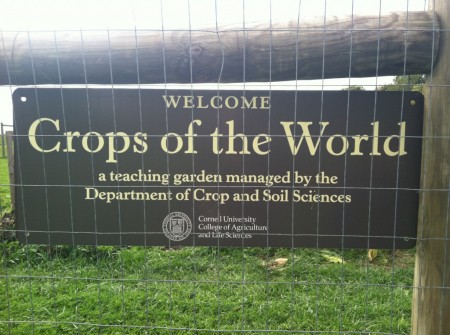 I’ve been researching poisons for some months now, and it was downright thrilling to encounter the actual toxic plants after having read about them. Kind of like bumping into a famous actor on the street after you’ve just seen him playing an evil villain in a movie. Here are some of the stars of the poison plant world I met:
I’ve been researching poisons for some months now, and it was downright thrilling to encounter the actual toxic plants after having read about them. Kind of like bumping into a famous actor on the street after you’ve just seen him playing an evil villain in a movie. Here are some of the stars of the poison plant world I met:
This is poison hemlock, of the species that killed Socrates. The sign says Foxglove, but that’s for a different plant: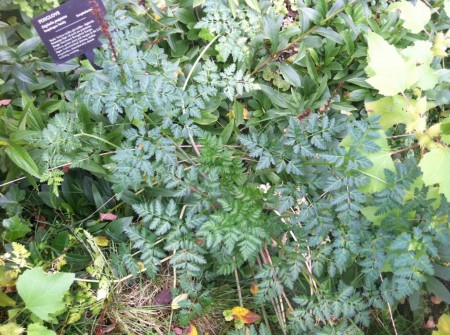 And here’s tobacco. The pink flowers were so pretty. I was surprised by how beautiful some of these plants were.
And here’s tobacco. The pink flowers were so pretty. I was surprised by how beautiful some of these plants were.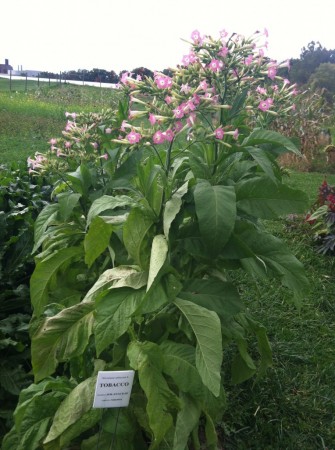 Another beautiful but oh-so-deadly one: Monkshood.
Another beautiful but oh-so-deadly one: Monkshood.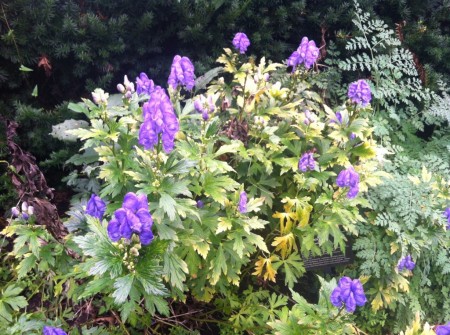 Here’s snakeroot, which poisoned (and killed) Abraham Lincoln’s mother (she died of “milk sick,” an all-too-common illness of many pioneer-era people). Professor Smith explained to me that the toxin is fat soluble, so the cow can eat snakeroot and not be harmed because she excretes it in her milk. But calves and people who drink the milk can be fatally poisoned.
Here’s snakeroot, which poisoned (and killed) Abraham Lincoln’s mother (she died of “milk sick,” an all-too-common illness of many pioneer-era people). Professor Smith explained to me that the toxin is fat soluble, so the cow can eat snakeroot and not be harmed because she excretes it in her milk. But calves and people who drink the milk can be fatally poisoned.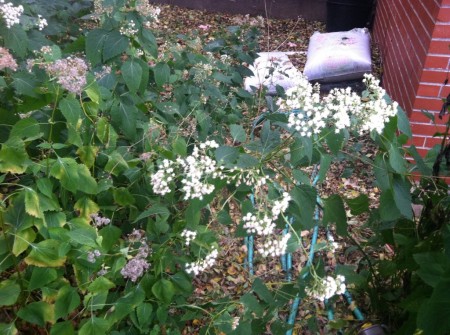 And THIS is Belladonna, aka Deadly Nighshade. I squealed when I saw it, as I hadn’t expected to see any, particularly in Ithaca, New York in early October—it’s a Mediterranean plant. It contains the alkaloid atropine, which is what makes your pupils dilate at the eye doctor’s. I don’t know if you can see those shiny black berries, but they do make for an impressively-ominous-looking plant:
And THIS is Belladonna, aka Deadly Nighshade. I squealed when I saw it, as I hadn’t expected to see any, particularly in Ithaca, New York in early October—it’s a Mediterranean plant. It contains the alkaloid atropine, which is what makes your pupils dilate at the eye doctor’s. I don’t know if you can see those shiny black berries, but they do make for an impressively-ominous-looking plant: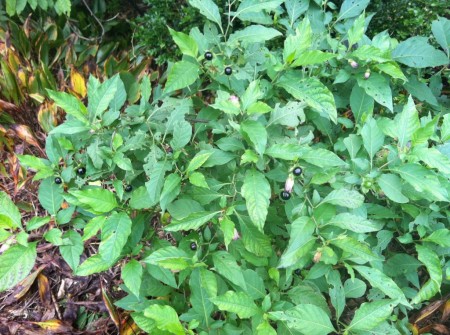 Here’s Datura stramonium, aka Jimsonweed, aka Jamestown Weed. Lots of cool history with this plant, starting with how the Jamestown settlers purportedly slipped some of this powerful hallucinogen into the food of British officers and then watched them put proverbial lampshades on their heads for several days. Can you see the fuzzy brown pod that’s split open and showing the black interior? That’s the most toxic part.
Here’s Datura stramonium, aka Jimsonweed, aka Jamestown Weed. Lots of cool history with this plant, starting with how the Jamestown settlers purportedly slipped some of this powerful hallucinogen into the food of British officers and then watched them put proverbial lampshades on their heads for several days. Can you see the fuzzy brown pod that’s split open and showing the black interior? That’s the most toxic part.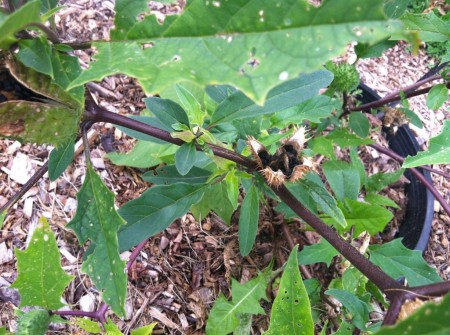 And this beautiful plant? Ricinus communus, aka the Castor bean plant. This is the plant that produces the poison ricin in its seeds. Ricin is five hundred times more toxic than arsenic or cyanide. (Fans of Breaking Bad will know this one.)
And this beautiful plant? Ricinus communus, aka the Castor bean plant. This is the plant that produces the poison ricin in its seeds. Ricin is five hundred times more toxic than arsenic or cyanide. (Fans of Breaking Bad will know this one.)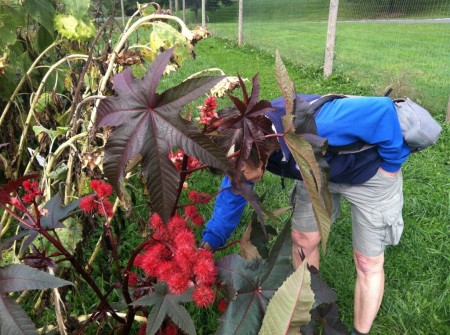 Here’s Professor Smith, photographing some castor bean seeds for her students to ID on an upcoming quiz:
Here’s Professor Smith, photographing some castor bean seeds for her students to ID on an upcoming quiz: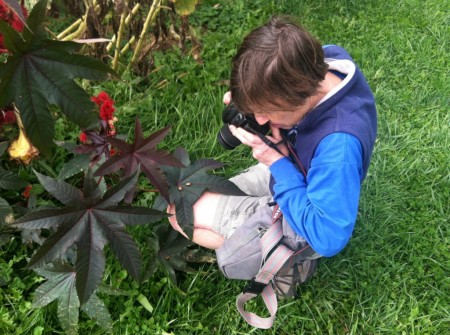 After she took the photo, she hopped up and handed me the two seeds to take home as a souvenir. It was . . . unsettling to find myself holding a potent poison in my bare hand in the middle of a field. I guess she realized I was a bit disquieted, because she pulled out a tissue and wrapped them up for me.
After she took the photo, she hopped up and handed me the two seeds to take home as a souvenir. It was . . . unsettling to find myself holding a potent poison in my bare hand in the middle of a field. I guess she realized I was a bit disquieted, because she pulled out a tissue and wrapped them up for me.
“Should I be worried about, er, you know, holding these in my bare hand?” I asked her.
“Nah,” she said, “although you’ll definitely want to wash your hands after this.”
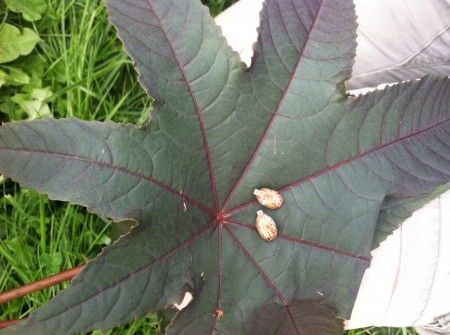 Follow up: after I got home last night and had washed my hands until most of the soap was used up, I looked up ricin in my notes. It turns out, two castor beans are enough to kill a person if one were to chew them (or pulverize them and slip them into someone’s tea). But because the hard seed coat prevents the body from absorbing the poison, the beans can pass harmlessly through a person’s system if swallowed whole, or held in one’s hand in the middle of a field.
Follow up: after I got home last night and had washed my hands until most of the soap was used up, I looked up ricin in my notes. It turns out, two castor beans are enough to kill a person if one were to chew them (or pulverize them and slip them into someone’s tea). But because the hard seed coat prevents the body from absorbing the poison, the beans can pass harmlessly through a person’s system if swallowed whole, or held in one’s hand in the middle of a field.